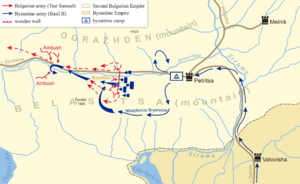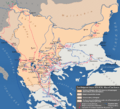Battle of Kleidion facts for kids
Quick facts for kids Battle of Kleidion |
|||||||
|---|---|---|---|---|---|---|---|
| Part of the Byzantine-Bulgarian Wars | |||||||
 The Byzantines defeat the Bulgarians at Kleidion and Tsar Samuel becomes unconscious at the sight of his blinded army. Scene from the Manasses Chronicle. |
|||||||
|
|||||||
| Belligerents | |||||||
| Byzantine Empire | Bulgarian Empire | ||||||
| Commanders and leaders | |||||||
| Basil II Nikephoros Xiphias Constantine Diogenes Theophylaktos Botaneiates † |
Samuel of Bulgaria Gabriel Radomir |
||||||
| Strength | |||||||
| Unknown | Unknown | ||||||
| Casualties and losses | |||||||
| Unknown | Devastating almost entire forces, allegedly 15,000 captured | ||||||
The Battle of Kleidion (also known as the Battle of Belasitsa) happened on July 29, 1014. It was a huge fight between the Byzantine Empire and the Bulgarian Empire. This battle was the most important moment in a long war. The war had lasted almost 50 years. It was fought between the Byzantine Emperor Basil II and the Bulgarian Emperor Samuel. The Byzantines won a very important victory.
The battle took place in a valley. This valley was between the Belasitsa and Ograzhden mountains. It was near the modern Bulgarian village of Klyuch. The main attack happened on July 29. A Byzantine general named Nikephoros Xiphias led a surprise attack from behind the Bulgarian army. This attack caused a huge defeat for the Bulgarians. Many Bulgarian soldiers were captured. Emperor Basil II ordered them to be blinded. Because of this, he became known as the "Bulgar-Slayer." Samuel survived the battle. But he died two months later. People say he died from shock after seeing his blinded soldiers.
Even though the battle didn't end the First Bulgarian Empire, it greatly weakened it. After Kleidion, Bulgaria found it much harder to fight the Byzantines. This battle is seen as the turning point of the war.
Contents
Why Did the War Start?
The conflict between the Byzantines and Bulgarians began a long time ago. In the 600s, the Bulgars created their own state. They settled along the Danube River. This area was once part of the Eastern Roman Empire. So, the Bulgarian state often fought wars with Byzantium. They wanted to protect their independence.
In 968, a Kievan prince named Sviatoslav invaded Bulgaria. At this time, the Bulgarian Empire was not as strong as it used to be. The Byzantines were also fighting the Bulgarians. This long conflict continued after the Bulgarian capital Preslav fell in 971. The Byzantine Empire took over eastern Bulgaria. They thought this would be the end of independent Bulgaria. But the western parts of Bulgaria remained free. Four brothers, known as the Comitopuli, led the resistance. Their names were David, Moses, Aaron, and Samuel.
When Byzantine emperor Basil II became emperor in 976, he had a big goal. He wanted to destroy independent Bulgaria. The western Bulgarians, led by Samuel of Bulgaria, stood against him. Basil II's first major campaign was a disaster. The Bulgarians destroyed the Byzantine army in the Gates of Trajan Pass in 986. Basil barely escaped with his life.
For the next 15 years, Basil was busy with other problems. Samuel used this time to take back many Bulgarian lands. He also attacked Byzantine territory. But his invasion of southern Greece ended in a big defeat. This was at the Battle of Spercheios in 996.
How Did Basil II Plan His Attacks?
Around the year 1000, Basil II was ready to focus on Bulgaria again. He launched many attacks. He took control of Moesia. In 1003, his forces captured Vidin. The next year, Basil heavily defeated Samuel in the Battle of Skopie. By 1005, Basil had taken back Thessaly and parts of southern Macedonia.
Over these years, a pattern emerged. The Byzantines would attack Bulgaria every year. They would besiege forts and raid the countryside. The Bulgarians had fewer soldiers. They could not fight the Byzantines directly in open battles. Instead, they launched smaller attacks in Macedonia and Greece. These attacks did not achieve lasting results. They also did not stop Basil from continuing his campaigns in Bulgaria.
A Bulgarian counter-attack in 1009 failed at the Battle of Kreta. The Byzantines did not win one single decisive battle. But their constant attacks slowly wore down the Bulgarians. They took away Bulgarian strongholds and weakened their army. A Byzantine historian, John Skylitzes, wrote about this. He said, "The Emperor Basil II continued to invade Bulgaria each year and destroy and devastate everything on his way. Samuel could not stop him in the open field or engage the Emperor in a decisive battle, and suffered many defeats and began to lose his strength."
The war reached its peak in 1014. Samuel decided he had to stop the Byzantine army. He wanted to prevent them from entering the heart of Bulgaria.
Preparing for the Battle
Samuel knew that the Byzantine army would have to cross mountain passes. So, he prepared to block them. The Bulgarians dug ditches along their border. They also built walls and towers in many valleys and passes. They especially fortified the Kleidion pass on the Struma River. Basil would need to go through this pass to reach central Bulgaria.
Samuel strongly fortified the northern slopes of the Belasitsa mountain. This was south and east of Strumitsa Castle. The wide valley of the Strumitsa River was a good place for an attack. Byzantine forces had used it before. The Bulgarians placed a strong guard there. Samuel also chose Strumitsa as his main defensive base. It was on the road from Thessaloniki to Thrace and Ohrid. The rough land to the south had earthworks and walls. Strong Bulgarian units guarded them.
Samuel decided to face Basil II at Kleidion for several reasons. He wanted to stop the constant defeats and invasions. These had devastated his country. He also worried about his authority among his nobles. Basil's campaigns had weakened his power. For example, in 1005, the governor of the important port of Dyrrhachium surrendered his town to Basil II.
To face this threat, Samuel gathered a large army. Some say it had as many as 45,000 soldiers. Basil II also prepared carefully. He gathered a large army and brought his most experienced commanders. This included Nicephorus Xiphias. Xiphias had captured the old Bulgarian capitals of Pliska and Preslav in 1001.
The Battle of Kleidion
The Byzantine army marched from Constantinople. They passed through Komotini, Drama, and Serres. They reached the Rupel pass on the Struma river. From there, they entered the Strumitsa valley. They arrived near the village of Klyuch. Here, the river curved and came close to Belasitsa and Ozgrazhden mountains.
At this point, a thick wooden wall stopped the Byzantine army. Bulgarian soldiers defended this wall. The Byzantines attacked the wall right away. But they were pushed back and suffered many losses.
In response, Samuel sent a large army south. It was led by a skilled Bulgarian noble named Nestoritsa. His goal was to distract Basil from the siege at Klyuch. Nestoritsa's Bulgarians reached Thessalonika. But Byzantine troops defeated them outside the city walls. This was a bloody battle. The Byzantine general, Theophylact Botaneiates, and his son Mihail led the defense. Theophylactus captured many soldiers and military equipment. He then marched north to join Basil at Klyuch.
Basil's first attempt to break through the pass failed. His army could not get past the valley. About 15,000 to 20,000 Bulgarians defended it. Despite the difficulties, the Byzantine Emperor did not give up. He ordered his general Nicephorus Xiphias to move his troops around the high Belasitsa mountain. Xiphias was to attack the Bulgarians from behind. Meanwhile, Basil continued his attacks on the wall.
Xiphias led his troops along a steep path. This path took him to the Bulgarians' rear. On July 29, Xiphias attacked the Bulgarian defenders. He trapped them in the valley. The Bulgarians left their towers to fight this new threat. This allowed Basil to break through the front line and destroy the wall.
In the chaos, thousands of Bulgarian troops were killed. The rest tried desperately to escape west. Samuel and his son Gabriel Radomir quickly rode from their headquarters in Strumitsa fortress. They wanted to help their army. But they were overwhelmed by the fast-moving enemy. This happened near the village of Mokrievo. Many Bulgarian soldiers were killed or captured at Mokrievo. Emperor Samuel himself barely escaped. His son bravely put his father on his own horse and took him to safety in Prilep. From Prilep, Samuel returned to Prespa. Gabriel Radomir went to Strumitsa to continue the fight.
What Happened Next?
After his victory, Basil II moved towards Strumitsa. This city was important for controlling the whole Vardar valley. On their way, the Byzantines captured the Matsukion fortress. Basil also sent an army under Botaneiates. This army was to surround Strumitsa. It was also to destroy all defenses to the south. This would clear the way to Thessalonica. With the rest of his troops, Basil began to besiege Strumitsa itself.
The Bulgarians allowed Botaneiates to destroy the fortifications. But soon after his task was done, Bulgarian raiders ambushed him and his army. This happened in a narrow valley. In the battle that followed, Botaneiates was completely defeated. The Bulgarian commander Gabriel Radomir personally killed Botaneiates with his spear. Because of this, Basil II had to stop the siege of Strumitsa and retreat. On his way back, a Byzantine official convinced the defenders of Melnik to surrender. This was another big loss for the Bulgarians. Melnik guarded the main road to Sofia from the south.
The Prisoners
Historians say that Basil completely defeated the Bulgarian army. They report he took 15,000 prisoners. Other historians say these numbers might be too high. A Bulgarian book from the 14th century says there were 8,000 prisoners.
Basil divided the prisoners into groups of 100 men. He ordered 99 men in each group to be blinded. One man in each group was left with one eye. This was so he could lead the others home. This harsh act was done for a few reasons. It was partly revenge for the death of Botaneiates. Botaneiates was Basil's favorite general. It was also meant to crush the spirit of the Bulgarians. In Byzantine times, blinding was a common punishment for rebels. Because of this action, Basil became known as Boulgaroktonos, which means "the Bulgar-slayer." Samuel died of a heart attack on October 6, 1014. People believe it was because he saw his soldiers blinded.
What Was the Impact of the Battle?
The death of Botaneiates and the four more years of war show that the Byzantine victory was not total. Some modern historians question if the Bulgarian defeat was as complete as described. Other historians believe that Emperor Samuel's death two months later was much more important for Bulgaria.
His sons, Gabriel Radomir and Ivan Vladislav, could not effectively fight Basil II. Bulgaria was completely defeated in 1018. In that year, Emperor Ivan Vladislav was killed in a battle. Bulgaria then became a province of the Byzantine Empire. It remained under Byzantine rule until a successful uprising in 1185. This uprising was led by the Asen brothers.
Other historians emphasize the importance of the battle itself. The Battle of Belasitsa caused heavy losses to the Bulgarian army. These losses could not be replaced. The central government's ability to control its provinces was reduced. The actions of local governors became more important for the war's outcome. Many of them surrendered to Basil II on their own.
The battle also affected the Serbs and the Croats. They had to accept the Byzantine Emperor's rule after 1018. The borders of the Byzantine Empire reached the Danube River again. This was the first time since the 600s. This allowed Byzantium to control the entire Balkan peninsula. This area stretched from the Danube to the Peloponnese. It also went from the Adriatic Sea to the Black Sea.
Images for kids








